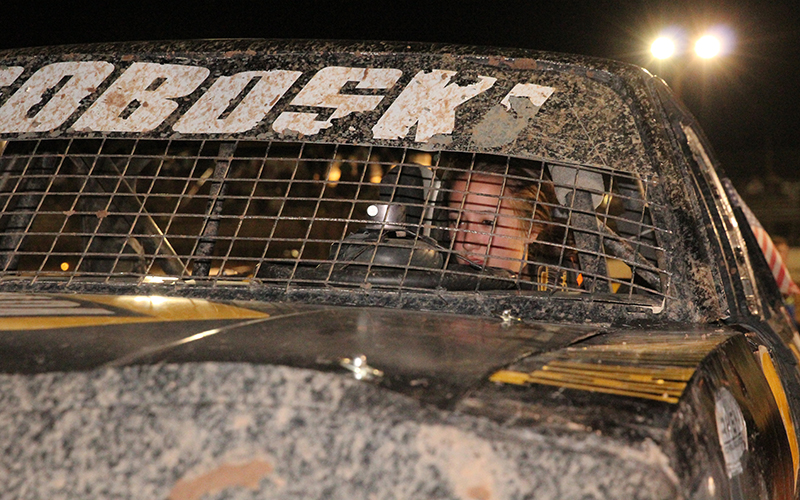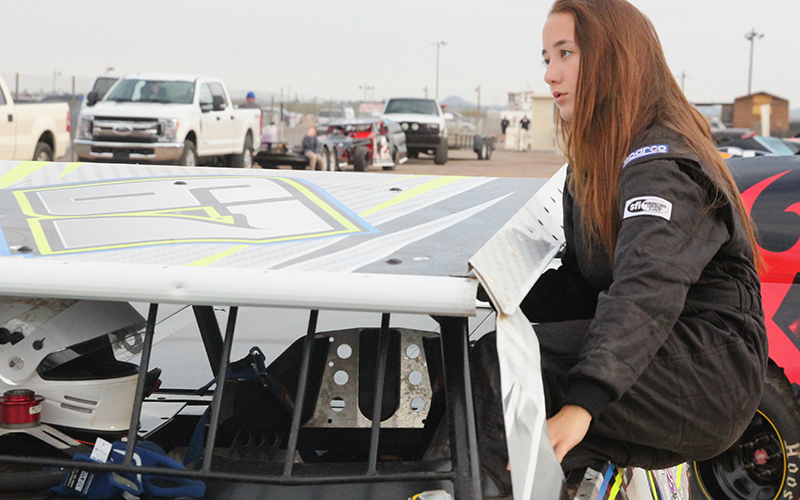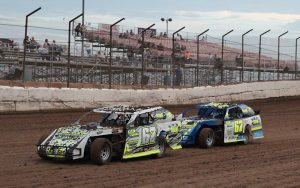
Abby Meulebroeck and her father, Travis, enjoy racing against one another. Even though she’s just 15, she has raced competitively for three years. (Photo courtesy Meulebroeck family)

Abby Meulebroeck prepares for the final race of the night. It’s a women’s only stock-car race. (Photo by Nate Fain/Cronkite News)

Abby Meulebroeck, 15, climbs into her car at Arizona Speedway. She had the opportunity to race against her dad on Father’s Day. (Photo by Nate Fain/Cronkite News)
QUEEN CREEK – Pyrotechnic flames shoot into the air as cars cross the finish line in the first heat of the Father’s Day weekend races at Arizona Speedway. Up next is Abby Meulebroeck. She climbs into her silver, steel-clad No. 67 car, tucks her long, brown hair under her white helmet and hits the gas. As the wheels of her car roll onto the damp, muddy track, and Meulebroeck joins a pack of seven other racers, the pressure mounts.
It’s a lot to ask of a 15-year-old girl who doesn’t even have her driver’s license.
“I get nervous before every race, but it’s just because of the waiting,” Meulebroeck said. “That feeling always goes away once the race starts.”
When Meulebroeck climbs behind the wheel, she isn’t trying to crash through the glass ceiling of a male-dominated sport. To her, Arizona Speedway has been accepting, eager to explore the possibilities of having more women in racing.
Only time will tell if that acceptance is reflected at the upper levels of the sport. In the 102 years of the Indy 500, only nine women have competed. And since 1949, when the first race of what has become the NASCAR Cup Series was held, only 16 women have reached that top rung of competition.
Meulebroeck is climbing the ladder.
Although she has a smooth, calm face and looks even younger than she is, she’s no rookie. She has been racing competitively for three years, often against competitors twice her age. But on this night, as her car picks up speed, she glances to the left into the visor of a very unique opponent: her father.
Travis Meulebroeck owns a flooring company, but he’s spent most of his time over the past 13 years racing.
“My old man was a racer. I’ve been around it my whole life,” Travis said.
Navigating the tricky turns on the inconsistent surfaces of dirt tracks is a family tradition in the Meulebroeck family, passed down generationally.
Now, it’s Abby’s turn.
“She’s going to beat you!” yells Austin Kuehl, a family friend and fellow racer who helped construct both of the Meulebroeck’s cars.
The starter waves his flag and the heat begins. The cars zoom around the 3/8-mile track, accelerating at speeds greater than 70 mph. Clumps of dirt and mud fly off the wheels and paint each car a nasty, dark brown. The Meulebroecks take the heat lightly, spending most of the race at the back of the pack. Travis is just getting a feel for his brand-new car. Abby is competing for only the second time this year, after taking a hiatus to focus on school, and just wants to get a feel for the speed, the adrenaline rush she’s been missing.
At Arizona Speedway, Abby has witnessed pileups, flipped cars and injured drivers. She’s been in a few wrecks herself. None of it seems to faze her. For the 10 minutes that the heat lasts, she is at her happiest.
A man’s game
She fell in love with racing, and the high that comes with driving as fast as possible, from the beginning. Skirting by the competition came naturally, so easy that she doesn’t even seem to understand how much of an anomaly she is.
Racing has long been considered a man’s game. But the Valley is home to several famous female racers. Lyn St. James and Danica Patrick, two of the nine women to qualify for the Indy 500, reside in the Phoenix area.
St. James now works with the Women’s Sports Foundation, trying to encourage more woman to get into racing.
“Racing is an individual sport, but it takes a team to get a car on the track,” St. James said. “We have a culture where women seem to be looking for an invitation to things, which makes it easy for them to get left out. Men don’t need an invitation. They just grab their buddies and show up.”
She says that things are better for women than they used to be, and that lesser-known dirt tracks, like Arizona Speedway, have a reputation for embracing female drivers. But real progress is hard to quantify.
“What we need is a good set of data,” St. James said. “All we have right now is anecdotal evidence, so it’s hard to say for sure if there are more or less female drivers than before.”
With Patrick’s recent retirement, the future of women in racing is even more unclear, but from what Abby sees, the upward trend has continued at Arizona Speedway.
“I’m the youngest driver out here, but I’m not the only girl,” she said. “I think dads without sons just started to let their daughters race, and now more and more are doing the same.”
Father’s Day fallout
After the heat, Abby and her dad still have another race. A four-lap one-on-one “Father’s Day Fallout” showdown.
The crowd of several hundred rocks the rickety wooden bleachers as the two No. 67 cars – Travis’ is blue – rip across the starting line. Father and daughter, holding nothing back, jostle for position as Travis, a two-time main event winner at Arizona Speedway, takes a slim lead.

Abby and Travis Meulebroeck face each other in a one-on-one Father’s Day showdown. Abby wins by passing Travis on the final lap. (Photo by Nate Fain/Cronkite News)
Coming around the final turn on the fourth lap, a slick patch of mud, created by a recent rainstorm, sends Travis’ car spinning out. Abby capitalizes and makes the pass to snag the checkered flag from her father’s grasp.
“This was pretty special to us because it’s maybe the only chance we’ll get to do this,” said Travis, as he and Abby get back in their trailer. “I’m probably going to sell one of these two models, so we won’t be able to compete against each other after this.”
The father-daughter duo race in a class called B-Mod, which features box-shaped cars with sharp, aerodynamic front bumpers. Because they run on a small engine and small wheels, B-Mods aren’t as expensive to maintain as other classes.
Abby also dabbles in the stock car division, where she once finished 14th of 24 drivers, her best result in a main event.
Family affair
The two park their cars, grab a couple of Gatorades and head up to the stands to watch the main event races with friends. The same familiar faces seem to roll into Arizona Speedway every weekend.
“Here, it’s like one, big family,” said Tony Morris, a friend of the Meulebroecks’ who works on one of their competitor’s cars. “I didn’t say a happy one though.”
Because the same several hundred people come to the track every weekend, factions have developed, and fights have broken out. Reckless drivers earn a reputation pretty fast out here.
“That guy is an idiot,” Travis quietly says as a driver hits another car’s back bumper on a sharp turn during the B-Mod main event. “Hopefully he’s not allowed back here.”
“He couldn’t keep control of his car during (warm up) laps,” Abby replies. “He should’ve known then not to race.”
They cheer on Kuehl, who’s now driving Abby’s car, to a fifth-place finish.
The final race
As the main events conclude and the trophies and prize money are collected, Abby puts her fire suit back on. She has one more race, one that might prove she’s right to think more women are getting into racing. It’s a stock car race featuring seven female drivers, ranging from drivers’ wives to Abby to full-time professionals, such as Shelby Frye.
Abby hops in the passenger’s seat of Travis’ truck and they drive back to the pits. Travis, with his orangish-blonde hair and skin that’s been reddened by the Arizona sun, offers his daughter advice.
“Gas it on the straightaways,” he says. “Stay high on those turns to avoid the mud.”
Abby, like any teenager, doesn’t seem interested in the advice. She just stares out the window, a stark contrast from her meticulous dad. It’s hard to tell if she’s fearless or oblivious. She might be a little of both. That just might be her style.
“I don’t really think too much out there. I just try and focus on what I need to do,” Abby said.
A low turn — one her father warned her not to make – gets Abby stuck behind a slower car. A fast final four laps aren’t enough to make up the deficit. She doesn’t win. Frye does.
Frye, like Abby, inherited the desire to drive from her father and began racing in go-karts at a young age. Now 24, Frye is winning championships on the asphalt track at Tucson Speedway. She says that Arizona Speedway and other tracks in the state are always accepting of female drivers because of their ability to attract an untapped demographic of fans. However, on the track the hostility grows.
“When I’m out there racing with guys, they don’t want to get beat. They really don’t want to get beat by a woman,” Frye said. “I notice that when I pull up next to somebody they seem to drive more over their head than they would when someone else is next to them.”
Abby watches the long hours that the full-time racers put into maintaining their cars and racing every weekend. She doesn’t know if she’s ready to give up trips to the beach and lazy Sundays watching the San Francisco 49ers just yet.
“I try to balance racing with other parts of my life,” Abby said
She’s not even a sophomore in high school, so she still has plenty of time to decide if she wants to fill the seat Patrick vacated at this year’s Indianapolis 500, but her dad knows racing is something she’ll have to commit her life to if she ever wants to do it for a living.
“Abby’s probably 80 percent into it right now,” Travis said. “I’m probably holding her back, having to work. If I spent more time out here, she’d be right here with me.”